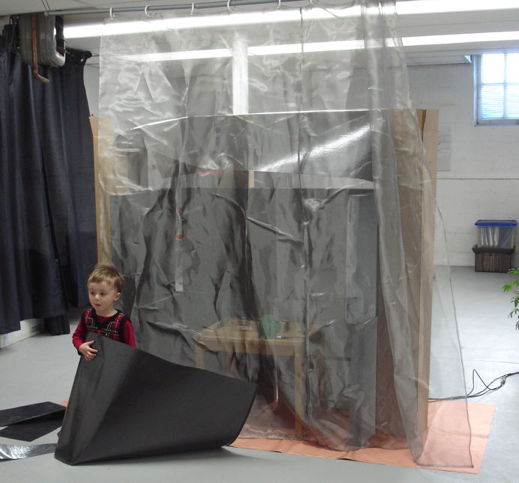
Figure: Proposed Radio-Frequency Isolation Chamber for a Large IVC Rack.
The chamber consists of absorber back and side walls, reflecting front wall and base mat, and open ceiling. Our sketch does not show the ventilation ducts entering and leaving the rack, but these can pass out above and below, or to the rear of, the side walls. The rear wall is 1.83 m square, made of 9 AN-77 absorbers. The gray side of these absorbers faces the cages in the rack. The black side is glued to an aluminum backing, which faces outward. The side walls are of the same construction, but made of 3 AN-77 absorbers each. In front of the rack is a curtain of transparent, conducting steel mesh. Below is a rubber mat that conceals a sheet of conducting fabric.
Radio waves approaching the isolation chamber are reflected away unless they pass through a gap or the ceiling. Such waves will pass through the rack once. If they arrive at an absorber wall, the chance of them being absorbed rather than reflected is 98.2%. If they hit the curtain or the mat, they will certainly be reflected, and so pass through the chamber a second time. If they reach the ceiling, they will exit the chamber. Such a chamber should reflect away 90% of incident interference. Some of the interference entering the chamber will pass through its volume twice because of the front and bottom reflectors, so interference power inside will be of order 15% the power outside. This 85% isolation is sufficient to guarantee 70% reception from an implanted transmitter at range 30 cm in the presence of −48 dBm interference, which is the strongest we have observed.
We arrange the eight independent antennas of Data Receiver (A3027B) on the shelves of the IVC rack. The sketch below shows how we might arrange these antennas to record from eight animal cages.

Figure: Proposed Arrangement of Antennas in an IVC Rack.
If we have a = b = 30 cm, and we consider the top-right cage, with an implanted transmitter on the far-right of the cage, we see that our arrangement provides two antennas at 30 cm, one at 42 cm and another five at greater ranges. We note that, because of the reflecting curtain at the front, there are two paths for radio waves to reach more distant antenna from our top-right transmitter. If we assume 70% reception for antennas at 30 cm, 50% from the antenna at 42 cm, and 20% from antennas up to 120 cm, and we further assume independence of message loss, we expect combined reception to be 98.5%.
We propose that ION perform the detailed design and construction of the rear and side absorber walls and the curtain rail. The walls should support the absorbers a few inches above the ground, and we should be able to remove each wall independently for comparative tests. The curtain rail likewise we should be able to remove with the entire curtain attached. We further propose that ION will select a rubber mat suitable for supporting the rack above the base reflector. At OSI, meanwhile, we will sew together the steel mesh curtain and cut the base reflector. We will prepare an A3027B Data Receiver and design a new loop antenna that fits easily between cages. We will provide transmitters to implant if necessary, so that we can test reception from within live animals.
UPDATE: [28-FEB-14] We make a curtain 2.0 m wide and 2.2 m high with curtain rings for the chamber test at ION. We hang the curtain in our office. We lay down a mat of copper teffeta fabric. We make a 1.2 m × 1.2 m absorber back wall and two 1.2 m × 0.6 m side walls. We suspend a piece of resistive sheet above the isolation chamber thus created. The result is shown below.

Figure: Isolation Chamber with Front Curtain.
We place three antennas on a table inside the chamber and three transmitters, which we move around to different places on the table. Reception without the chamber is 0-100% because of intermittent −58 dB ambient interference at 926 MHz. With the chamber as shown, we get reception 95-100%. When we move aside the curtain, reception drops to 70-100%. Peak interference power in the closed chamber is around −64 dB.
No comments:
Post a Comment